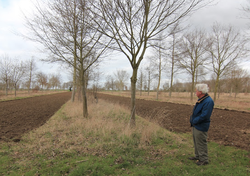 Having had the pleasure of visiting and researching some of the best agroforestry sites in Europe I thought some folks might enjoy this interview I filmed with Professer Martin Wolf over in Suffolk, UK. The video is probably far too slow if you suffer a 3-minute-social-media-saturated-attention-span but personally I would happily sit and listen to Martin for hours. The video begins with Martin recounting his work as a grain disease specialist at Cambrige University- which led to broad scale East German adoption of multi- variety grain production and subsequent huge reductions in fungicides (which quickly fell apart when the wall came down) 350,000 ha under this production system in Germany sadly fell to 20,000ha almost overnight. The N-S alley cropping at Martin's site generally utilizes 12m spacings trialling Hazel and Willow coppice, diverse long term hardwood timber species and nut & fruit plantings. Both pasture and alley cropping with grains are harvested in between. I've seen systems on 8- 26m spacings, but like Martin we are going to base our system at Ridgedale on 12m spacings for maximum beneficial interactions between our systems. Our Keyline layout means a lot of our alley rows are conveniently on a N to S orientation. I constantly see the beneficial opportunities for integrating various tree systems into existing enterprises in my design work. A lot of farms could benefit from the addition of various tree systems for a whole range of reasons, and this is one element of regenerative design that is usually fairly easily integrated. Below is a list of some of the benefits of silvopastural/ silvoarbale systems, something we shall explore in detail as we implement our Keyline patterned agroforestry systems in our 2014 Internship program. Benefits of silvopastural/ silvoarbale systems
2 Comments
13/7/2017 04:18:26 am
Could a version of this excellent interview please be released without the sound track? Like you, I could listen to Martin for ages, but I found it very difficult to hear over the soundtrack, which was very intrusive at times.
Reply
Timothy Riggs
9/6/2022 05:48:31 am
As a spring barley breeder at the former Plant Breeding Institute, Cambridge, I worked with Martin over a number of years and visited him in Suffolk a year or two before he died. I think it's important that his ideas and farming practices are carried forward, and would welcome information on how Wakelyns is being managed now.
Reply
Leave a Reply. |
Details
Like us on FB Below for regular updatesStay up to date with customized updates you want to receive
Upcoming coursesArchives
December 2016
Categories
All
|

 RSS Feed
RSS Feed